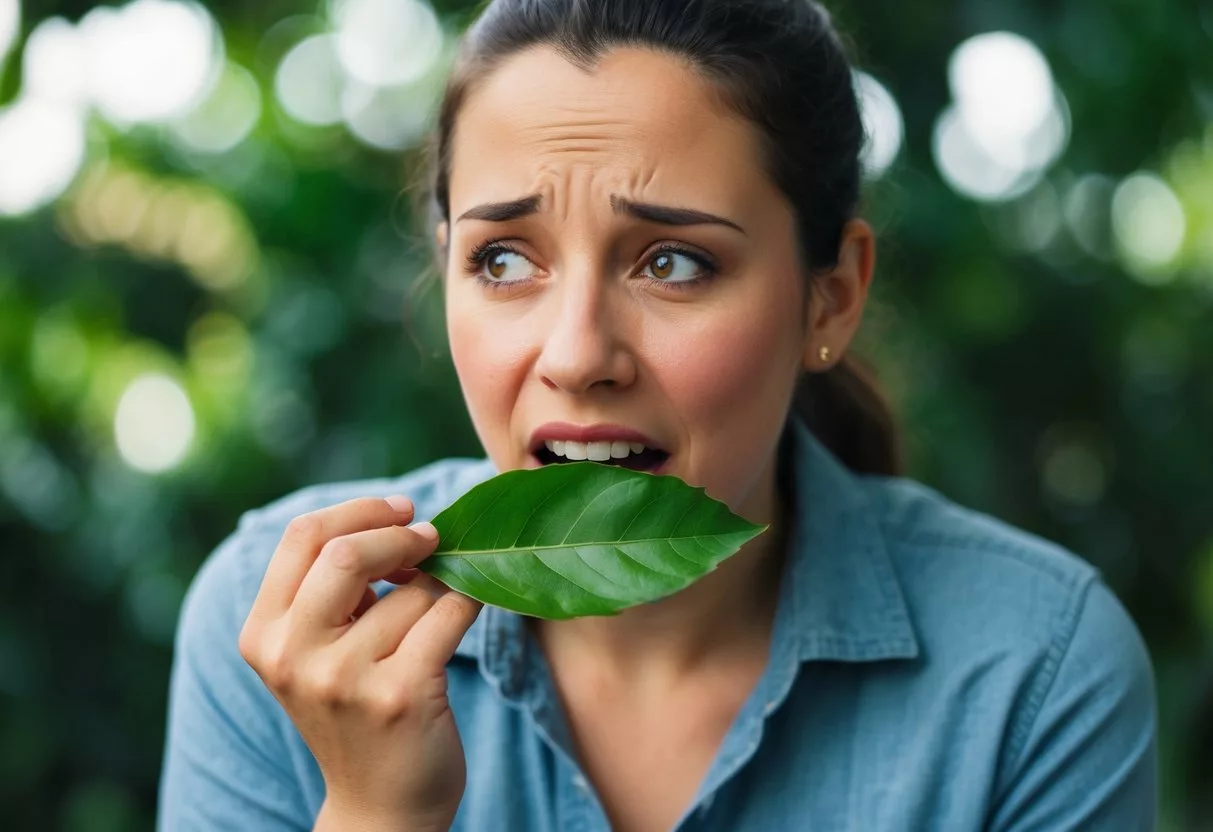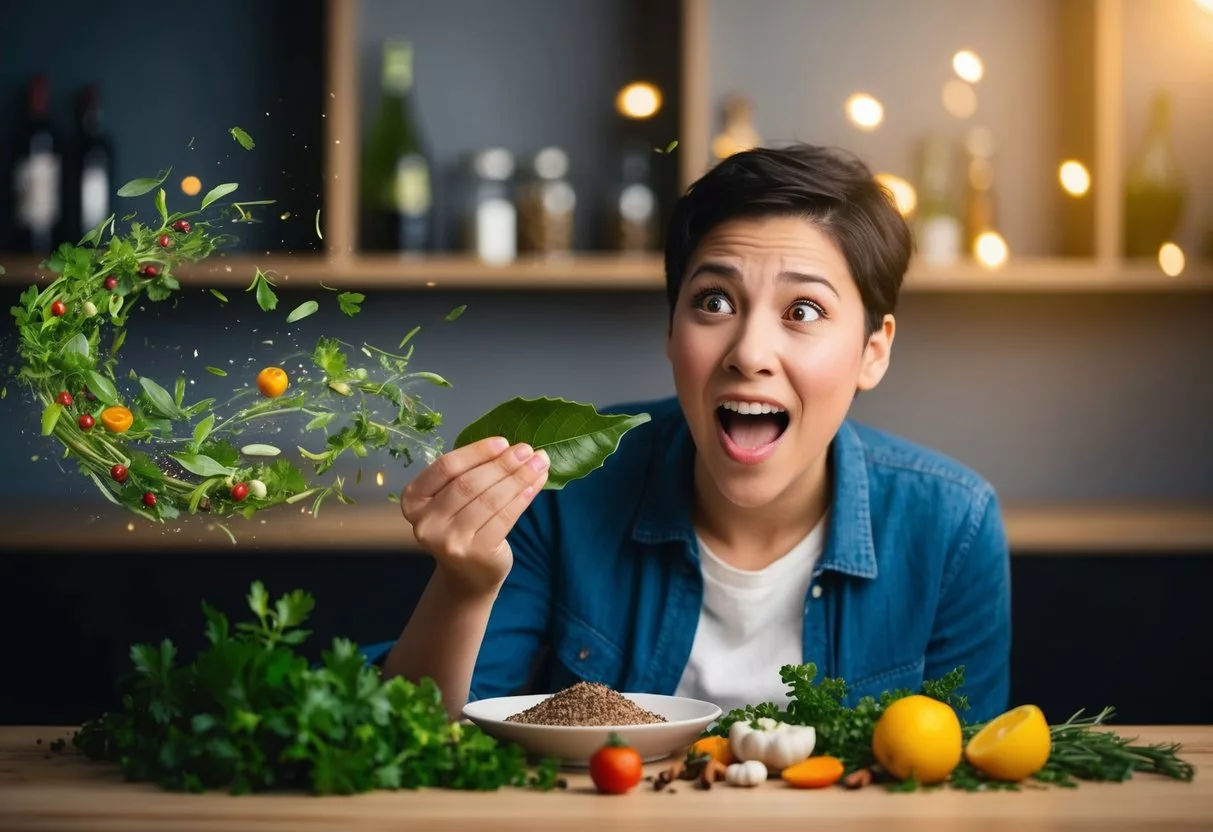Bay leaves are a common ingredient in many dishes, adding flavor and aroma to soups, stews, and sauces. While these fragrant leaves enhance the taste of food, they’re not meant to be eaten whole. People often wonder what might happen if they accidentally swallow a bay leaf while enjoying their meal.
If you accidentally eat a bay leaf, it’s unlikely to cause serious harm, but it may be uncomfortable. Bay leaves are tough and don’t break down easily during digestion. This means they could potentially scratch your throat or digestive tract as they pass through. In rare cases, a bay leaf might get stuck in the throat, causing discomfort or choking.
Cooks typically remove bay leaves before serving food to prevent accidental ingestion. If you find a bay leaf in your dish, it’s best to set it aside rather than try to eat it. While bay leaves are safe for cooking, they’re meant to infuse flavor, not to be consumed whole.
Understanding Bay Leaves
Bay leaves are a common herb used in cooking. They add a distinct flavor to many dishes. Bay leaves come from the bay laurel tree and have been used for centuries in various cuisines.
Botanical Profile
Bay leaves come from the bay laurel tree[1], scientifically known as Laurus nobilis. This evergreen tree is native to the Mediterranean region. It can grow up to 60 feet tall in the wild. The leaves are dark green, glossy, and oval-shaped with pointed tips.
Bay laurel is different from other plants with “bay” in their names. Cherry laurel and mountain laurel are not related and should not be used for cooking. Only Laurus nobilis is safe and suitable for culinary use.
The bay laurel tree has been cultivated for thousands of years. Ancient Greeks and Romans used bay leaves for cooking and in religious ceremonies.
Culinary Use
Bay leaves have a subtle yet distinct flavor. They add depth to many dishes. Cooks often use bay leaves in soups, stews, sauces, and marinades. The leaves release their flavor slowly during cooking.
Most recipes call for whole bay leaves. Cooks add them at the start of cooking and remove them before serving. Bay leaves work well with other herbs like oregano and thyme.
Some key ways to use bay leaves:
- Add to simmering liquids
- Include in a bouquet garni
- Use in rice dishes
- Add to meat marinades
The flavor of bay leaves is hard to describe. It’s somewhat floral and slightly bitter. Bay leaves also have a subtle minty or tea-like taste.
Common Forms in Cooking
Bay leaves come in three main forms: dried, fresh, and ground. Each has its own uses in cooking.
Dried bay leaves are the most common form. They have a stronger flavor than fresh leaves. Dried leaves keep their flavor for about a year when stored properly. Most recipes that call for bay leaves mean dried ones.
Fresh bay leaves have a milder taste. They’re less common but becoming more available. Fresh leaves are more pliable than dried ones. Some cooks prefer them for their brighter flavor.
Ground bay leaves are the least common form. They’re made by grinding dried leaves into a powder. Ground bay leaves have a strong flavor and should be used sparingly. They’re often used in spice blends or rubs.
Safety and Risks of Bay Leaves

Bay leaves are common in cooking, but eating them whole can pose risks. They have sharp edges and don’t break down easily when chewed. This can lead to problems if swallowed.
Choking Hazards
Bay leaves can be a serious choking risk[2] if eaten whole. Their stiff texture and pointed edges make them hard to swallow safely. They can get stuck in the throat or esophagus.
If a bay leaf gets lodged, it may block the airway. This can cause trouble breathing or complete airway obstruction.
People should always remove bay leaves from food before eating. Cooks should count how many leaves they add and take out the same number when done cooking.
Digestive System Considerations
Swallowing a bay leaf can affect the digestive system. The leaf doesn’t break down easily in the stomach or intestines.
It may cause:
- Stomach discomfort
- Irritation of the digestive tract
- Potential blockages
In rare cases, a swallowed bay leaf could lead to more serious issues like tears in the digestive lining. This is uncommon but possible due to the leaf’s sharp edges.
Toxicity Concerns
Bay leaves used in cooking (bay laurel) are not toxic when eaten in small amounts. But some people confuse them with other plants that look similar.
Cherry laurel and mountain laurel leaves can be toxic if eaten[3]. These plants are not safe for cooking or eating.
It’s important to know which type of bay leaf you’re using. Only use bay laurel leaves from trusted sources for cooking. If unsure about a plant, don’t use its leaves in food.
What to Do After Ingesting Bay Leaves
Bay leaves can pose risks if swallowed whole. Quick action and knowing when to get help are key for safety after accidentally eating bay leaves.
Immediate Response
If you swallow a bay leaf, stay calm. Take small sips of water to help move it down. Do not try to vomit, as this may cause more harm. Eat soft foods like bread or banana to help push the leaf through your system.
Watch for signs of choking or breathing problems. If these occur, get emergency help right away.
Most people pass bay leaves without issues. But keep an eye out for pain or discomfort in the next few days.
When to Seek Medical Help
Seek medical care if these symptoms appear:
- Severe abdominal pain
- Vomiting
- Difficulty swallowing
- Fever
- Blood in stool
Go to the ER if choking or breathing problems happen. While bay leaves aren’t toxic, they can cause blockages. A doctor may need to remove the leaf if it gets stuck.
Tell the doctor when and how many leaves were swallowed. This helps them give the right care.
Preventive Measures
Taking simple steps can help avoid accidentally eating bay leaves. These measures focus on safe cooking practices and proper use of bay leaves in recipes.
Safe Cooking Practices
Always count bay leaves before adding them to dishes. Keep track of how many you use. Remove bay leaves before serving meals. This prevents them from being accidentally eaten.
Use whole bay leaves instead of crushed ones. Whole leaves are easier to spot and remove. Place bay leaves in a bouquet garni[4] for easy removal. A bouquet garni is a bundle of herbs tied together.
Inform guests about bay leaves in dishes. This helps them watch out for them. Store bay leaves separately from other herbs to avoid mix-ups.
Proper Usage of Bay Leaves in Recipes
Use bay leaves sparingly in cooking. One or two leaves are often enough for most recipes. Add bay leaves early in the cooking process. This allows their flavor to infuse fully.
Remove bay leaves after cooking. Don’t leave them in dishes for long periods. In soups and stews, fish out bay leaves before serving.
For marinades and sauces, strain the liquid to catch any bay leaf pieces. Avoid grinding or chopping bay leaves. This makes them harder to remove later.
Consider alternatives like bay leaf powder for some recipes. Powdered forms eliminate the risk of accidentally eating whole leaves.
Alternative Herbs and Spices

Bay leaves add a unique flavor to many dishes. Cooks often look for substitutes when they run out or want to try something different.
Substitutes for Bay Leaves
Oregano is a popular alternative to bay leaves in many recipes. It has a similar earthy flavor and works well in soups and stews. Thyme is another option that can mimic the herbal notes of bay leaves.
For a more intense flavor, cooks can use a small amount of juniper berries. These provide a pine-like taste that’s close to bay leaves. Rosemary is also a good choice, especially in meat dishes.
Some people prefer to use basil as a substitute. While its flavor is different, it can add a nice herbal touch to tomato-based recipes. In a pinch, a dash of dried sage can work too.
It’s important to note that these substitutes may change the taste of a dish slightly. Cooks should start with small amounts and adjust to taste.
References
- drniki – BiBi Therapy. https://bibitherapy.com.au/author/drniki/ Accessed November 4, 2025
- The Green Pharmacy: New Discoveries in Herbal Remedies for Common Diseases ... - James A. Duke. https://books.google.com/books?hl=en&lr=&id=VxpZDwAAQBAJ&oi=fnd&pg=PR14&dq=Safety+and+Risks+of+Bay+Leaves+What+Happens+if+you+Accidentally+Eat+Bay+Leaves+&ots=Mi41x3XLtD&sig=6NpyADgM6KTTdH20PuI30Efl76s Accessed November 4, 2025
- How to Poison Your Spouse the Natural Way: A Guide to High-Risk Dining - Jay D. Mann. https://books.google.com/books?hl=en&lr=&id=ebW4QzlolAUC&oi=fnd&pg=PA5&dq=Safety+and+Risks+of+Bay+Leaves+What+Happens+if+you+Accidentally+Eat+Bay+Leaves+&ots=YBvU1m0VwA&sig=hvgwEX-EiZIxWsCzihNYOwqDCrQ Accessed November 4, 2025
- Dangerous Tastes: The Story of Spices - Andrew Dalby. https://books.google.com/books?hl=it&lr=&id=7IHcZ21dyjwC&oi=fnd&pg=PA7&dq=Preventive+Measures+What+Happens+if+you+Accidentally+Eat+Bay+Leaves+&ots=20-zdNk1Qc&sig=q_y_da5Z3qJiUzPciYLmk3En7rA Accessed November 4, 2025
